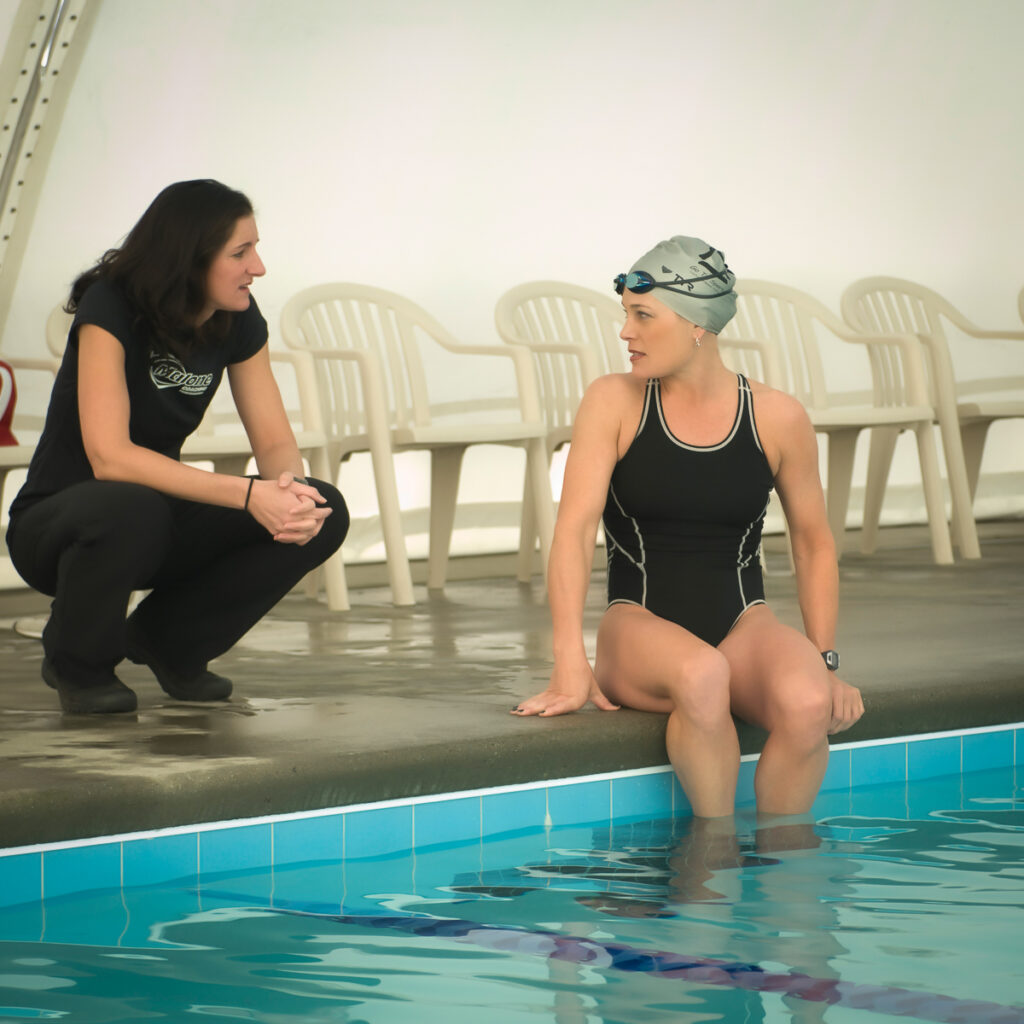“Here is what goes through my head on a 100m effort in a group swim….
Five seconds after she leaves I go. Ok, go. Pace my arms evenly. Count strokes, breathe in the pocket, lead with my middle finger, keep the anchor arm out, don’t drop my right arm when I breathe, oops! There’s the wall, streamline, how many strokes was that? Must have been 15 because there were two strokes before the turn, keep it long, don’t hold your breath – exhale evenly. Am I leading with my middle finger? Think fingertip drill – keep those elbows high, 11 – 12, there are the flags, this is going to be 16, damn, whoa, almost hit that guy on the turn, is he getting closer? Focus, don’t shorten up, anchor arm, breathe behind you, are those her bubbles? Or my bubbles? Would I even be able to see my own bubbles? Keep your head down, look for the bottom of the pool, hook your arm at the catch so I feel the lats, no, that doesn’t mean drop your anchor arm, there has to be a tipping point there. Hey! there’s a guy in the lane next to me – wonder if I can stay with him, there’s the blue T…if I stretch I can flip…damn nearly missed the wall on that one. Ok, I must be close to her because it’s getting really choppy in here. Breathe evenly, stay long. Is she going to be pissed if I smack her feet? If I angle my arms to the right lane line maybe I won’t hit her. I think that was the same number of strokes per length except the first one. I wonder how many we’ve done? Good thing she’s counting. Oops – there’s the wall”
Recent recollections from Juliet, a former Olympian, newer swimmer, and cerebral athlete.
This excerpt is an interesting thought process to analyze. Most of the technical elements are super relevant, and the experiential aspect of trying to improve technique and swim faster while navigating other athletes is something we can all relate to.
The reality is how can you possibly improve with so much going on at once? For the newer swimmer, I like to simplify. You have to finish elementary school before you go on to high school and college. As adult swimmers, we often try and skips steps and go straight to college.
I like to encourage my newer swimmers to pick simpler themes, and try not to overthink things.
Consider these 5 points, and try not to go on to the next step until you have mastered the prior step!
- Relax and Play.
Many of us over achieving super-swimmer-wannabees try too hard. We are robotic in our movement and our mind is cluttered. Watch a kid swim. They are loose, fluid and sometimes are goofing around in there. They move, play and feel the water.
Breath. Smile. Loosen up. Enjoy moving through the water. This is your play time.
- Float and Glide.
Heavy legs are anchors and wide legs make a wide slow boat. While you are relaxing, (see #1) focus on floating. Keep your head low and your legs shallow, be horizontal. Push off the wall, ride the glide, swim narrow and swim shallow.
- Pick a Simple Theme.
Once you can float, then you can pull and kick. We all have technical elements to work one. Pick one! Visualize moving well before you get in the water, and pick a single technical cue to practice that day, or for at least half the practice. When you fix one thing you often inadvertently fix something else too. It’s a biomechanical chain reaction.
- Quantify and Feel.
How do you know if you are improving if you don’t measure it? Counting strokes is a great way to measure efficiency. Less strokes to get to the end of the pool sounds efficient, right? Count regularly. Time yourself each day and FEEL how fast you are moving. After a while you can internalize an effort and know how fast you are swimming without looking at the clock. That’s handy in open water.
When you are good at counting and timing, you can combine the two. Taking fewer strokes at the same finish time is a nice indication of increased efficiency. You will feel more water pressure against your arms and you will feel your body flow fluidly through the water.
- Focus on what’s working.
Swimming is technical and sometimes things don’t click. Rather than over analyzing, or reconstructing your stroke, instead focus on something that is working. If your left arm catch is wonky, focus on your stroke rate. If your kick timing is off and you just can’t get it, focus on your breathing. If you are working hard and times are not great today, focus on relaxing and swimming the same times with less effort. Reinforce a positive element in your stroke rather than fixating on one that isn’t.
Lance Watson, LifeSport head coach, has trained a number of Ironman, Olympic and age-group Champions over the past 30 years. He enjoys coaching athletes of all levels. Contact Lance to tackle your first IRONMAN or to perform at a higher level.
